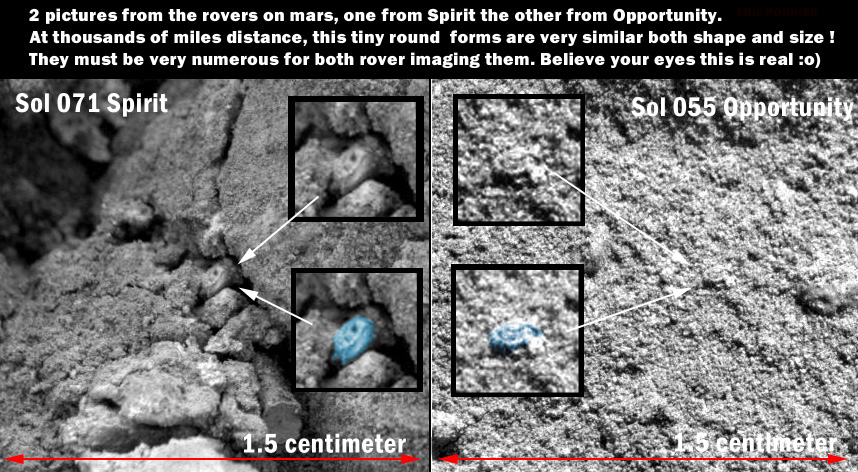
The images are from Opportunity Sol 55 - m/055/133072793EFF06GOP2956M2M1 and Spirit Sol 71 m/071/133072734EFF06GOP2956M2M1 respectively. Actually, if you look carefully there are others in the same image.
The reader should approach these rings with the same caution that he or she looks at the rotini-like objects. If fossils they may be either complete small hard marine protists or possibly just a pieces from an unknown larger whole. Alternatively, they could just be a disintegrating bit of crystal, or, specks of dirt held together by electrostatics or magnetism, or, an weird interaction between poor image focus and the jpeg compression algorithm, or finally the eye projecting order onto random lights and shadows. The great danger is that they are just figments of the viewer's imagination, hence the name "hallucinogenia". With that warning in mind, they shouldn't be dismissed either. Displayed here are nine hallucinogenia rings -- a few a bit questionable maybe. The structures shown here mostly are about 1 mm in diameter. No match has ever been found to the first astonishing one found by Eric.
1./ Eric Pouhier of Paris France posted the following on alt.sci.planetary on March 24, 2004.
"Bio-morphologies seen on Mars by the two rovers thousands of miles away from each other!"
He was the first to point out these objects.
The original was at
http://tourlaville.nerim.net/Trustyoureyesthisisreal.jpg.

The images are from
Opportunity Sol 55 - m/055/133072793EFF06GOP2956M2M1 and
Spirit Sol 71 m/071/133072734EFF06GOP2956M2M1
respectively.
Actually, if you look carefully there are others in the same image.
2./
Here is a second ring from the same Spirit sol 71 image as above.
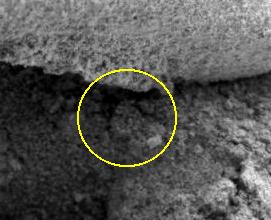
|
And here is a second ring from Eric's
Opportunity Sol 55 image.
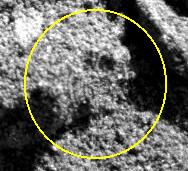
|
|
3./ Another correspondent, a certain Marvi, has a good eye for finding hallucinogenia.
Here are three of them from
Spirit Sol 073 - 2M132842726EFF2000P2977M2M1 that he pointed out.
Marvi's original study of the sol 73 image highlighted other curiousities as well.
The one on the right seems almost to be a miniature ringed horodyskia - being little archaeobacteria spherules linked together into a ring. Marvi sends along the wise caveat. "Poor resolution combined with suggesting a feature by way of circling them may lead a viewer to see something...that is not actually there (like forms in the clouds)." Here is another finding by Marvi as well from Opportunity Sol 025 1M130405277EFF0400P2953M2M1
|
|
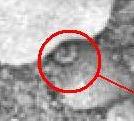
|
4./ Pier Luca Toffano of Italy sends another sighting of a hallucinogenia specimen from Opportunity sol 52. It is a nice find. Click here to see the enlargement. The original is here. 1/m/052/1M132808298EFF06A8P2956M2M1 |
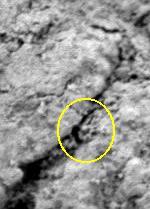
|
5./ A hallucinogenia from the abraded rotini image. Sol 33.
Again, the two original images are full of curious things.
|
|
Our Readers Write Department: "I've looked at a lot of forams from the Eocene of the Gulf Coast. I can see a resemblence to large forams such as Lepidocyclina and Discocyclina and even some of the smaller forams. What came to mind when I first saw the images on your web site were these wee beasties... http://www.nhm.ac.uk/hosted_sites/ina/CODENET/GuideImages/ ...although the martian examples would have to be many orders of magnitude larger. In function, it would make sense if these were actually fossil martian Coccoliths. From what I can remember, Coccoliths are very simple organisms. The structure contains lenses (the round "windows" you see in the images) that focus light onto a chloroplast for photosynthesis. I'd guess that a organism with similar function could have existed in an alien ocean? Whatever they are...I'd LOVE to have them under my microscope. :-)" Jeff
|
|
|
Not exactly hallucinogenia, but concentric circular arcs from Opp sol 125 outside of Endurance Crater.
About 2 mm in diameter.
/1/m/125/1M139283564EFF2829P2976M2M1 |
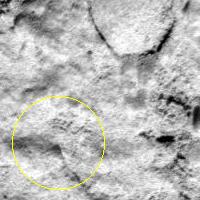
|
|
A supposed root from the Gusev Crater Spirit site.
It is found below the Spirit wheel just described previously.
It is probably a nothing.
One millimeter in diameter and two millimeters long.
Spirit :: Microscopic Imager :: Sol 071.
m/071/2M132663815EFF1800P2973M2M1 |
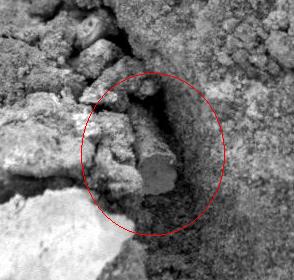
|
|
9./ Spirit image of sol 122.
The image shows possible a spherule stem, a candidate hallucinogenia,
and maybe even a new rotini.
Marvi's study /2/m/122/2M137197682EFF4204P2959M2M1 |
|
|
The filament at the Opportunity site - sol 19.
NASA thinks this is a thread of
Vectran from rover landing air bags
and this makes a lot of sense as the
image was taken on top of one of the in-coming bounce marks.
Alternatively it might be a stray fibre from the fibre glass insulation
or whatever it was that was blowing around
the Opportunity site and was imaged as the infamous "Mars Bunny".
In the microscopic images taken from deep in the martian soil, both at the Spirit and the Opportunity sites, short linear features or filaments are occasionally sighted. These most likely bits of fibrous minerals such as natrolite, chrysotile or asbestos that have blown in from somewhere and have dust sticking to them. Natrolite typically forms through precipitation from hydrothermal solutions on the walls of cavities in basalt and related volcanic rocks and so it may not be uncommon in the mostly basalt Gusev crater where Spirit is roaming. It is highly unlikely that they would be freeze-dried roots or martian fungus strands, or my personal hoped-for favourite, linear chains of archaeobacteria microspherules, or anything biological like that.
Here are some other microscopic images from Spirit that show filaments.
You have to look carefully for them.
They are there, but they do not display well for me to present. Hamdi Ucar of Turkey has made a careful study of the soil fibres and has found them to be of several discrete types and occuring in most localities. Here are two Hamdi Ucar's study images: 11-ss-11-interpen-B038R1-b. and 2m130169205eff0514p2943m2m1.
|

Vectran filament from Opportunity sol 19 - 1M129869847EFF0338P2953M2M1 Notice the hook at the end -- approximately 8 mm long. | |||
|
A marvellous spirally wrapped thread. Opportunity Sol 106 from Hamdi. Hamdi's study /1/m/106/1M137593920EFF2208P2956M2M1 |
|
|
A microscopic soil study from Spirit sol 105.
Little beads of dust have gathered on a mineral fiber, maybe chrysotile.
The fancily decorated pebble is about 4 mm in diameter.
The features highlighted here are a result of mineral fiber and dust and
electrostatics
and are not vegetable or biological or fossils.
The bottom edge, and especially the lower left hand corner, of this image is
very busy with fibers.
The dark spot on the pebble is not a micrometeor impact crater.
Any micrometeor grain of sand impacting with the pebble would have lost all
its velocity coming through the Martian atmosphere. Spirit Sol 105. /2/m/105/2M135687606EFF3000P2956M2M1 Soil study from Noel C. Welstead, Brisbane, Australia |
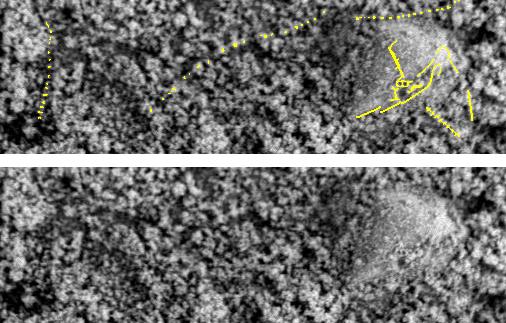
|
|
7./ The "Twig". If you enjoy looking for oddities in martian soil, check out this image. The twig is about two thirds the way down, left hand side and is about 4 mm end to end. This charming specimen was sent to me by Liam Tucker of Brisbane Australia. Opportunity :: Microscopic Imager :: Sol 116. m/116/2M136662584EFF37CAP2957M2M1 Here is Marvi's study of this image. Marvi says "By the way, I found that for an initial quick scanning of the image, a big magnifying glass provides analog zooming more comfortably than digital zooming." It might be a bit of fibrous mineral like chrysotile or asbestos that blew in. |
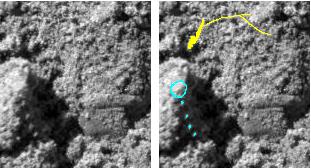
|
||
|
| |||
|
| |||
|
10./ From Opportunity sol 25.
Two odd concentric circles in the soil with filaments.
Did something decompose there?
They are about 3/5ths down the right hand side.
The soil in the centre is brighter than that surrounding it.
Marvi points out that there are two "stems", shown also in yellow,
leading into the bright yellow circle.
Marvi's study /1/m/025/1M130405277EFF0400P2953M2M1 |
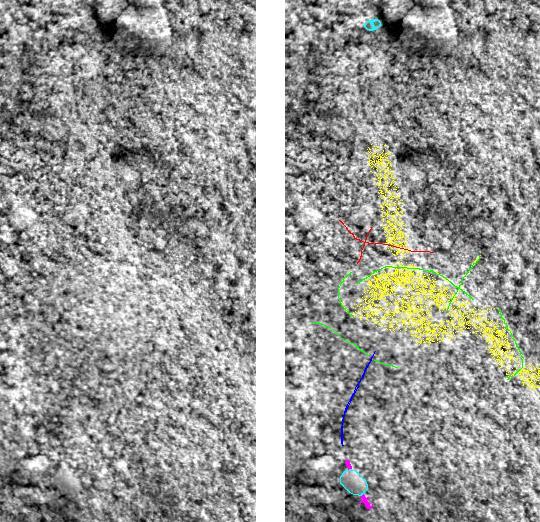 Martian fairy ring?? 4 mm in diameter. It is uncertain exactly what the features pointed to in this analysis image are and what caused them. Maybe it is a little piece of sulphur breaking up. One weak possibility is that these features might have a biological origin. Negative Shadow Study by Marvi Marvi writes: "I sent a negative to provide a better contrast and definition of the feature. Maybe this will convince exceptics who might argue that we are seeing 'Jesus in a tortilla chip'. ... I am glad you think that there is a chance, however remote, that this feature could be due to some biogenic processes. An alternative question might be: how could this kind of feature can be formed from a purely geological point of view, and with no biology involved? ... We also have to remember that these features are only a few millimiters wide." |
Many thanks again to Eric, Jeff, Pier Luca, Hamdi, Noel, and especially Marvi for their contributions to this page.